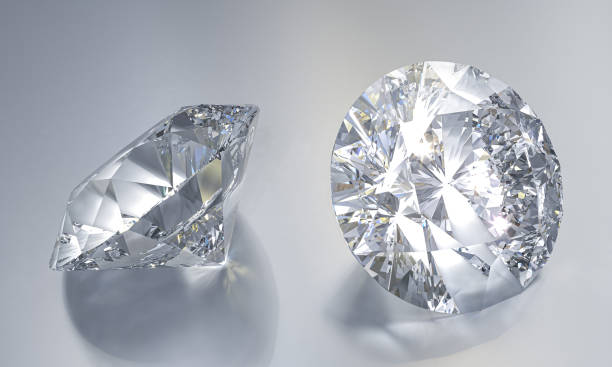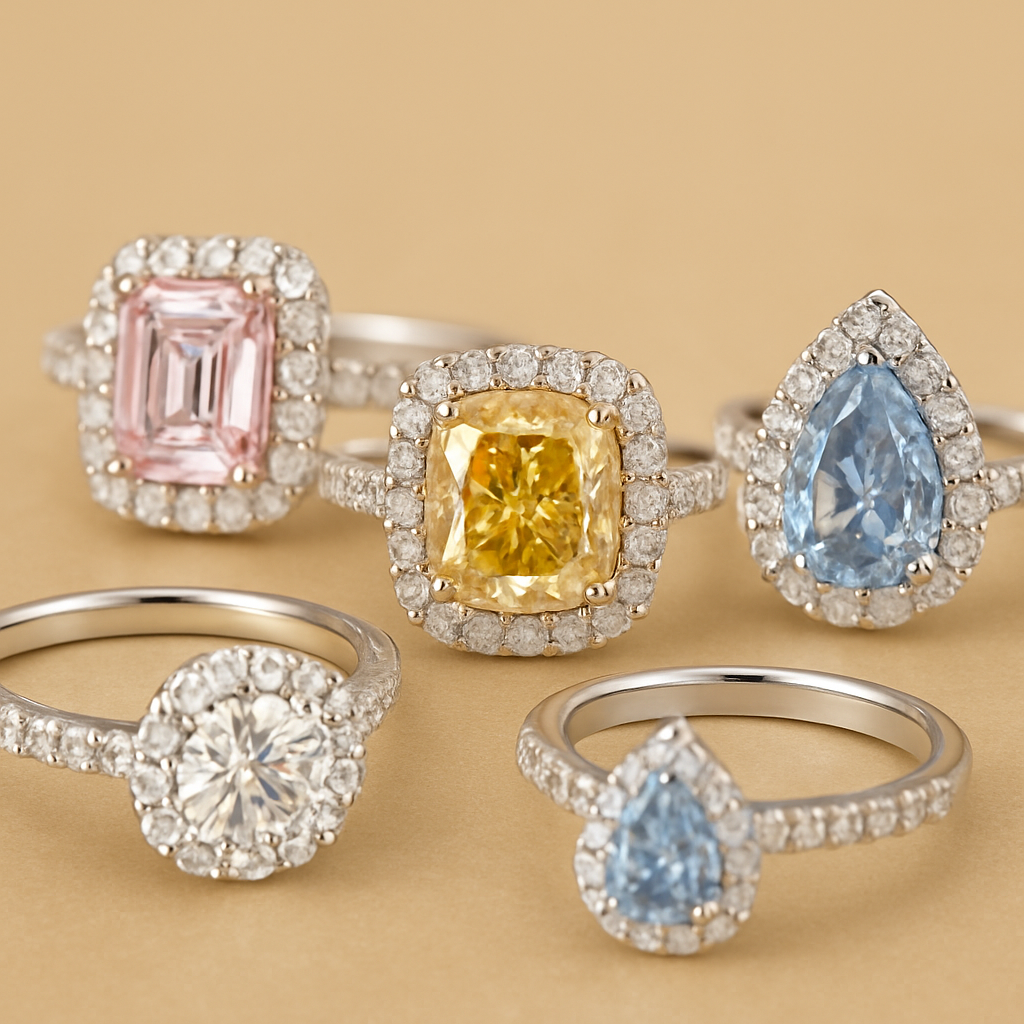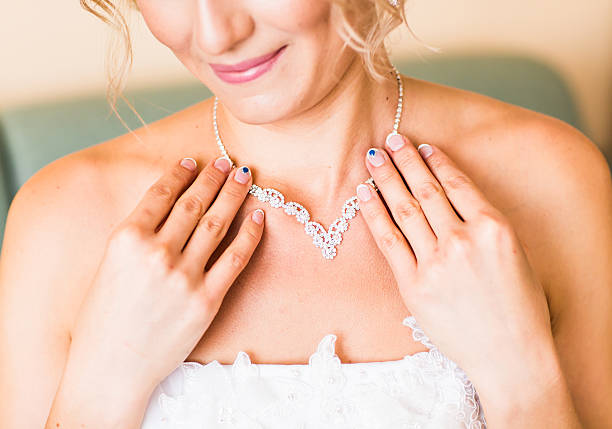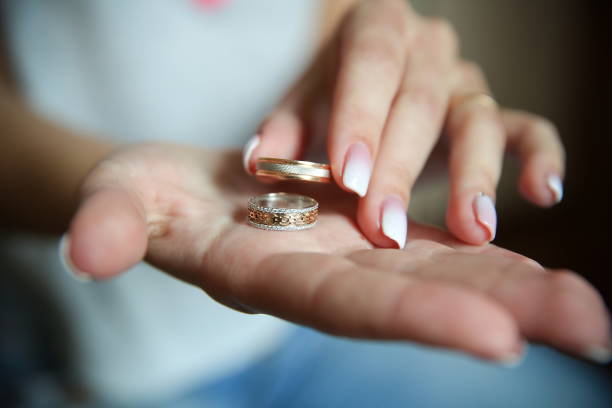When it comes to diamonds, the round brilliant cut is in its own league. It's the most commonly sought-after diamond shape in the world and the ultimate engagement ring and luxury jewelry choice. Its flawless symmetry and masterfully crafted facets provide the most amount of sparkle, fire, and brilliance — attributes that have entranced jewelry enthusiasts for generations.
This comprehensive guide will take you through it all that you should know about round diamonds — from their rich history and scientific craftsmanship to handy tips on choosing, setting, and maintaining your diamond to keep it shining for a lifetime.
What Is a Round Diamond?

At first sight, a round diamond may appear as merely a circular gem. However, the beauty of a round diamond is that its precisely cut facets — generally 57 or 58 — are aimed at optimizing light performance.
- Facets: The crown (top) of the diamond typically consists of 33 facets, and the pavilion (bottom) consists of 24 facets, with the occasional addition of a culet (a small facet on the bottom point).
- Light Reflection: These angles are deliberately cut to grab incoming light, bounce it inside, and send it back to the viewer's eye as stunning sparkle.
In contrast with fancy cuts, which can focus on size or individual looks, the round brilliant cut is designed first for light optimization, so it is the brightest diamond shape.
The Fascinating History and Evolution of the Round Brilliant Cut
The history of the round brilliant cut is one of genius and mathematical accuracy. Marcel Tolkowsky, a young gemologist and mathematician, released in 1919 a groundbreaking thesis detailing the method for cutting diamonds to achieve maximum brilliance and fire.
- Ideal Cut Formula: Tolkowsky relied on advanced geometry and optics to formulate the proportions subsequently referred to as the "ideal cut."
- Impact: His contribution turned the process of diamond cutting into a science from what it once was – an art – changing practices everywhere.
- Evolution: Contemporary diamond cutters continue to perfect these ratios, employing state-of-the-art technology like laser cutting and computer-aided 3D modeling to create stones that meet or surpass ideal cut grades.
Currently, the round brilliant cut comprises more than half of all diamonds sold worldwide.
Key Characteristics of Round Diamonds: Brilliance, Fire & Scintillation
A round diamond's beauty is because of the combination of three optical phenomena:
- Brilliance: The return of white light to the eye, resulting in the overall brightness of the diamond.
- Fire: The splitting of light into spectral hues, producing rainbow flashes.
- Scintillation: The flashes and glints of light when the diamond or light source is in motion.
Proper balance necessitates exact angles, symmetry, and facet alignment.
Cut Grade: The Most Important Factor
Cut quality influences the manner in which light is reflected back from the diamond. The Gemological Institute of America (GIA) rates cuts from Excellent to Poor.
- Excellent Cut: Returns the maximum brilliance and fire.
- Very Good Cut: Almost as brilliant but less accurate.
- Lower cuts compromise sparkle, causing the diamond to look dull even if other characteristics are high.
When purchasing a round diamond, cut grade is important — it affects beauty more than any other "C."
How to Choose the Perfect Round Diamond: Deep Dive into the 4Cs
1. Cut
Cut decides the brilliance and worth of the diamond. Considerations are:
- Proportions: Table size, crown angle, pavilion depth.
- Symmetry: Facet alignment.
- Polish: Refinement of facet surfaces.
- A great cut guarantees light is reflected maximally, giving an eye-catching effect.
2. Color
Diamonds are measured against a color scale ranging from D (colorless) to Z (light yellow/brown). Round diamonds are highly versatile and tend to look whiter because brilliance hides minor color.
- Ideal Range: D to H is desirable for near-colorless appearance.
- Settings Make a Difference: Platinum or white gold white metals bring out colorlessness; yellow or rose gold can warm up slightly lower color grades.
3. Clarity
Clarity quantifies inclusions and blemishes within or on the diamond surface.
- Grades: Flawless (FL), Internally Flawless (IF), Very Very Slightly Included (VVS1, VVS2), Very Slightly Included (VS1, VS2), Slightly Included (SI1, SI2), Included (I1, I2, I3).
- Round Diamonds: Buyers can choose slightly lower clarity levels without noticeable defects because brilliance hides the majority of inclusions.
4. Carat Weight
- Carat refers to the weight of the diamond, not size. Heavier carats exponentially raise the price because of scarcity.
- Perception: Round diamonds experience more light return loss compared to fancy shapes, so carat size impacts sparkle.
- Balance: Buyers often balance carat with cut and clarity for the best beauty and cost.
Certification
Buy only diamonds that have been graded by well-known labs like GIA, AGS, or IGI in order to ascertain transparency and quality.
Popular Settings That Complement Round Diamonds
The round diamond’s classic shape pairs with diverse settings, including:
-
Solitaire: Timeless and minimalist, focuses solely on the diamond’s sparkle.
-
Halo: A circle of smaller diamonds accentuates size and brilliance.
-
Pavé: Diamonds embedded in the band add sparkle and texture.
-
Three-Stone: Symbolizes past, present, future — emotionally meaningful.
-
Vintage: Intricate filigree and milgrain work enhance old-world charm.
-
Tension: Modern and edgy, diamond appears to float between bands.
Choosing a setting depends on personal style, lifestyle, and how much emphasis you want on the diamond.
Caring for Your Round Diamond Jewelry
To maintain your diamond's fire and brilliance:
- Ongoing Cleaning: Gently brush, warm water, mild soap. No harsh chemicals.
- Impact Avoidance: Although diamonds are hard, they can chip under hard hits.
- Secure Storage: Separate storage in soft pouch or box.
- Annual Professional Maintenance: Inspections guarantee prongs and settings secure.
Why Choose a Round Diamond?
The round brilliant cut is still the icon of eternal love and sophistication because:
- It has maximum sparkle with no other shape able to compare.
- It is symmetrical to fit almost every style of jewelry.
- It has robust resale value and ageless beauty.
- It's a versatile option that suits all ages and occasions.
Whether you prefer a traditional solitaire or a blinding halo ring, the round diamond fits perfectly.
Fun Facts About Round Diamonds
- Round diamonds represent approximately 75% of all diamonds sold globally.
- The "ideal cut" was mathematically defined to achieve maximum sparkle, as opposed to previous cuts that maximized size.
- The round brilliant is also referred to as the "Queen of Cuts" due to its unparalleled beauty.
- Diamonds cut shallow or too deep lose their brilliance, thus exact proportions are crucial.
Final Thoughts
Opting for a round diamond is opting for brilliance, heritage, and a stone that has been loved and admired for centuries. With the proper education of cut, color, clarity, and carat, you can choose a diamond that sparkles in your eye and represents your own special love story.
At San Liora, our skilled team is here to assist you on your diamond journey — showing you the way to discover your ideal round diamond that sparkles as brightly as your future.
Discover our exclusive round diamond collection today and let your brilliance shine for a lifetime.







